Table of Contents
A SHORT AUDIO OF THE POST
Introduction
Nothing beats the comforting warmth of homemade halwa on a festive evening or when you want to treat your family to something special. This comprehensive guide is perfect for home cooks who love traditional indian sweets and want to master the art of making gajar halwa recipe, moong dal halwa, suji halwa recipe, and wheat halwa from scratch.
These easy halwa recipes transform simple ingredients like carrots, lentils, semolina, and wheat into rich, aromatic desserts that have been loved across generations. Each carrot halwa recipe and semolina halwa brings its own unique texture and flavor profile to your dessert table.
We’ll walk you through the essential ingredients and equipment needed for perfect halwa making, plus share detailed step-by-step instructions for each indian dessert recipes. You’ll also discover pro tips and troubleshooting techniques that ensure your halwa recipes turn out perfectly every time, whether you’re making them for Diwali celebrations or a cozy family dinner.
Essential Ingredients and Equipment for Perfect Halwa Making
Core ingredients common across all four halwa varieties
Ghee stands as the star ingredient across all traditional indian sweets, providing that rich, aromatic base every halwa needs. Full-fat milk creates the creamy texture, while sugar or jaggery adds sweetness. Cardamom powder brings authentic flavor, and a handful of mixed nuts like almonds, cashews, and pistachios provide the perfect crunch and visual appeal.
Specialized ingredients unique to each halwa type
Halwa Type | Key Ingredient | Special Additions |
|---|---|---|
Gajar Halwa | Fresh carrots (2 lbs) | Khoya/mawa for richness |
Moong Dal Halwa | Yellow moong dal (1 cup) | Extra ghee for authentic taste |
Suji Halwa | Fine semolina (1 cup) | Saffron strands optional |
Wheat Halwa | Whole wheat flour (1 cup) | Coconut flakes for texture |
Must-have kitchen tools and equipment
A heavy-bottomed pan prevents burning during the lengthy cooking process that authentic halwa recipes demand. You’ll need a fine-mesh strainer for dal preparation and a wooden spatula for continuous stirring. A food processor helps grate carrots quickly for carrot halwa recipe preparation, while measuring cups ensure perfect proportions every time.
Tips for selecting high-quality ingredients
Choose bright orange carrots that feel firm and heavy for the best gajar halwa recipe results. Fresh moong dal should have a uniform yellow color without black spots. Pick fine-grade semolina that feels smooth between your fingers for perfect suji halwa. Always buy pure ghee from trusted sources, as it makes the biggest difference in taste and aroma across all easy halwa recipes.
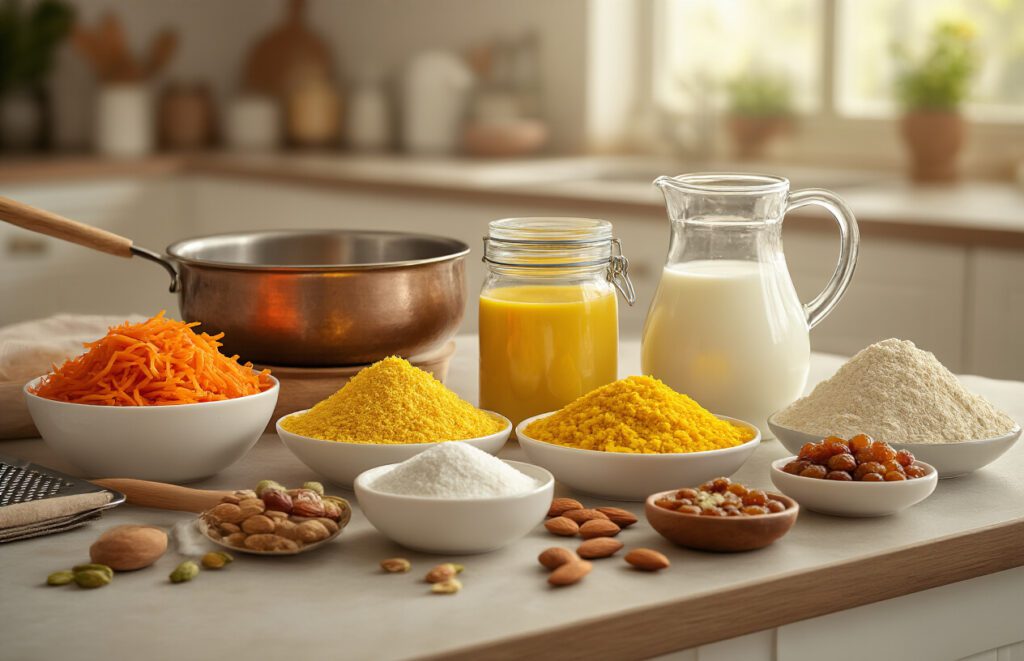
Master the Art of Gajar Halwa - The Classic Carrot Dessert
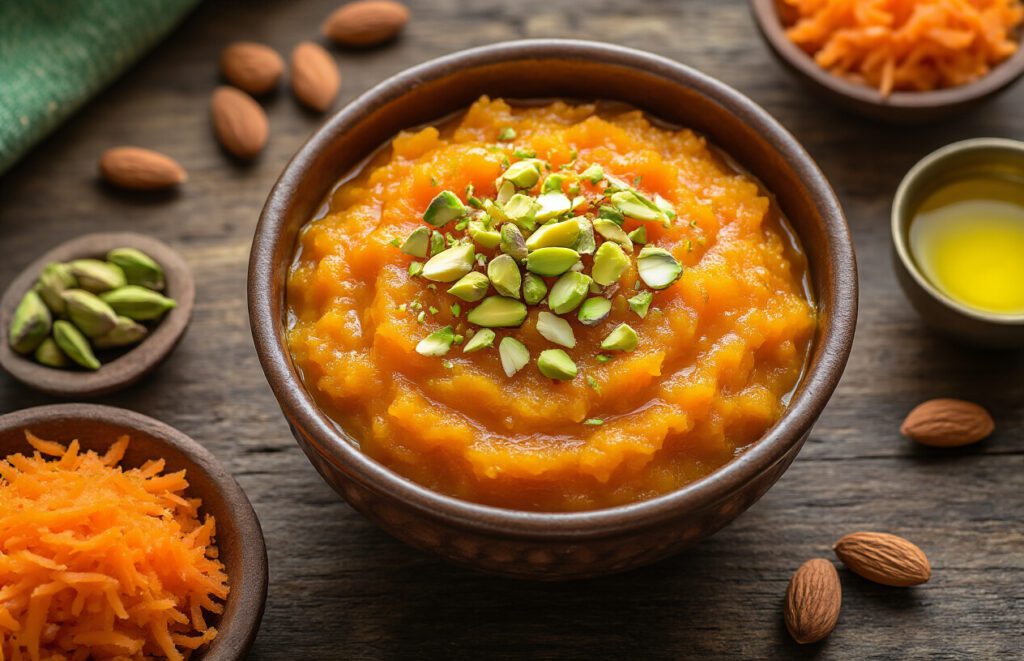
Step-by-step preparation method for authentic taste
Start by washing and peeling 1 kg fresh carrots, then grate them finely using a box grater. Heat 2 tablespoons ghee in a heavy-bottomed pan and add the grated carrots. Cook on medium heat for 8-10 minutes, stirring occasionally until the raw smell disappears and carrots begin to soften.
Pour 1 liter full-fat milk into the pan and bring to a boil. Reduce heat to low-medium and simmer uncovered, stirring frequently to prevent sticking. Add 4-5 crushed green cardamom pods and continue cooking for 45-60 minutes until the carrot halwa recipe develops a rich, thick consistency and the milk reduces significantly.
Achieving the perfect texture and consistency
The secret to perfect gajar halwa lies in patience and constant stirring during the milk reduction phase. When the mixture starts pulling away from the pan sides and forms a cohesive mass, add 3/4 cup sugar and mix thoroughly. Cook for another 15 minutes until the sugar dissolves completely and the halwa reaches a glossy, pudding-like texture.
Add chopped almonds and cashews along with 2 more tablespoons of ghee for extra richness. The finished carrot halwa recipe should have a moist yet firm consistency that doesn’t spread when served. Garnish with silver leaf and additional nuts for an authentic presentation.
Common mistakes to avoid while cooking
Never rush the cooking process by increasing heat, as this causes the milk to curdle and creates an uneven texture. Avoid using low-fat milk since the fat content is essential for achieving the creamy consistency characteristic of traditional indian sweets. Skipping the initial ghee-roasting step results in a watery halwa that lacks depth of flavor.
Don’t add sugar too early in the cooking process, as it prevents proper milk reduction and creates a runny consistency. Always use fresh, sweet carrots rather than old or bitter ones, which can ruin the entire dish’s taste profile.
Create Delicious Moong Dal Halwa - The Protein-Rich Sweet
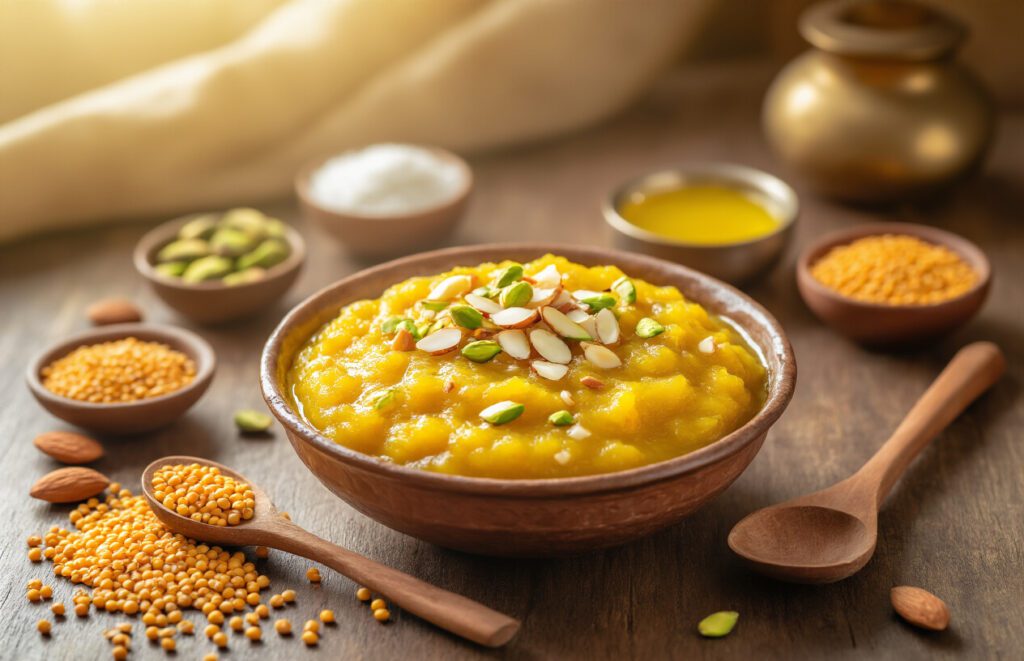
Proper soaking and grinding techniques for moong dal
Start by soaking split yellow moong dal in warm water for 2-3 hours until it softens completely. This makes grinding easier and creates a smoother texture. Drain thoroughly and grind into a coarse paste using minimal water – the consistency should be thick, not watery. Fresh moong dal halwa requires this perfect balance for authentic taste.
Temperature control for smooth cooking process
Cook the ground moong dal paste on medium-low heat, stirring constantly to prevent sticking. Add ghee gradually while cooking until the mixture turns golden and releases a nutty aroma. This slow cooking process takes 15-20 minutes but creates the silky texture that makes moong dal halwa irresistible. Patience during this step ensures perfect results every time.
Garnishing options to enhance presentation
Garnish Type | Options |
|---|---|
Nuts | Almonds, pistachios, cashews |
Dried fruits | Raisins, dates |
Aromatic | Silver leaf, rose petals |
Top your moong dal halwa with toasted nuts and a sprinkle of cardamom powder for extra flavor.
Storage tips to maintain freshness
Store in airtight containers in the refrigerator for up to 5 days
Reheat gently with a splash of milk before serving
Freeze portions for up to 3 months
Always use clean, dry spoons when serving
Perfect Suji Halwa - Quick and Easy Semolina Delight
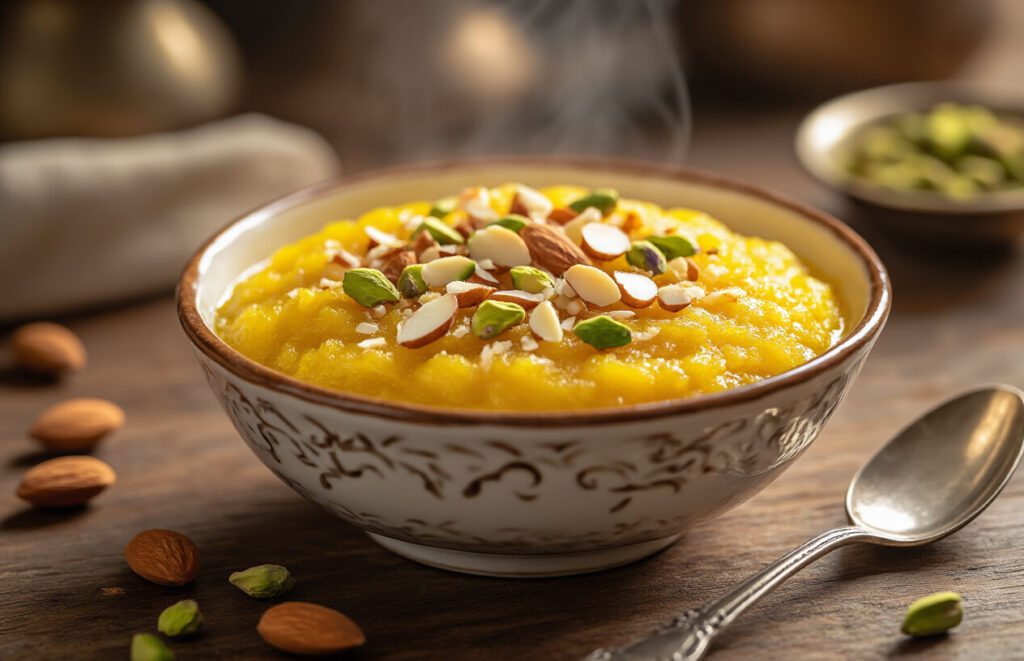
Roasting semolina to achieve golden color and aroma
Toast semolina in a heavy-bottomed pan over medium-low heat, stirring constantly for 8-10 minutes until it turns golden brown and releases a nutty fragrance. This crucial step prevents lumps and creates the signature texture that makes suji halwa recipe so beloved.
Water-to-semolina ratio for ideal consistency
The perfect semolina halwa requires a 1:4 ratio of semolina to liquid. For every cup of roasted semolina, use 4 cups of hot water or milk. Add the liquid gradually while whisking continuously to achieve smooth, creamy consistency without any lumps forming in your traditional indian dessert.
Flavor variations using different nuts and spices
Customize your easy halwa recipe with chopped almonds, pistachios, or cashews for crunch. Add cardamom powder, saffron strands, or rose water for aromatic depth. Some prefer coconut flakes or dried fruits like raisins to create unique variations of this classic indian dessert recipe.
Traditional Wheat Halwa - Nutritious and Satisfying Recipe
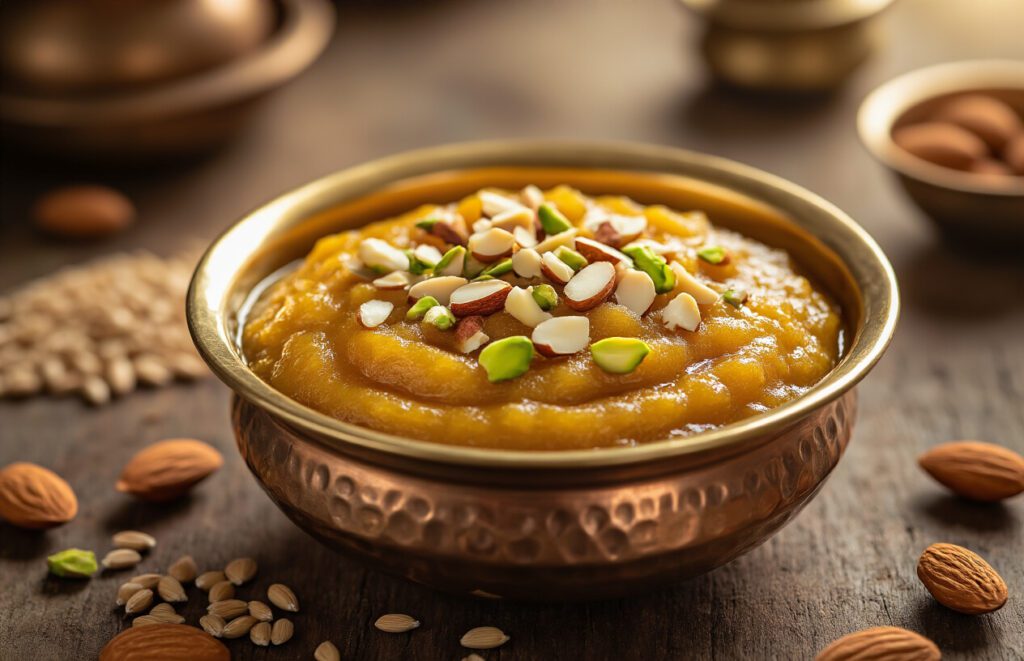
Wheat flour preparation and roasting techniques
Start by dry roasting wheat flour in a heavy-bottomed pan over medium-low heat for 8-10 minutes until it turns golden brown and releases a nutty aroma. Stir continuously to prevent burning and ensure even roasting. The flour should feel slightly warm to touch and have a deeper color than raw flour.
Ghee incorporation for rich taste and texture
Add ghee gradually while the roasted flour is still warm, mixing thoroughly to create a smooth paste. Use approximately 2-3 tablespoons of ghee per cup of flour for optimal richness. This wheat halwa technique prevents lumps and creates the signature glossy texture that makes this traditional indian sweet so appealing.
Serving suggestions for special occasions
Serve hot garnished with chopped almonds, pistachios, and a pinch of cardamom powder. Present in small bowls alongside other indian dessert recipes during festivals like Diwali or Karva Chauth. Pair with hot milk or chai for a comforting evening treat.
Health benefits of wheat-based desserts
Wheat halwa provides complex carbohydrates, fiber, and essential B vitamins that support digestive health and sustained energy. Unlike refined sugar desserts, this wholesome sweet offers protein and minerals from wheat flour, making it a more nutritious option among halwa recipes for growing children and active adults.
.
Pro Tips for Halwa Success and Troubleshooting
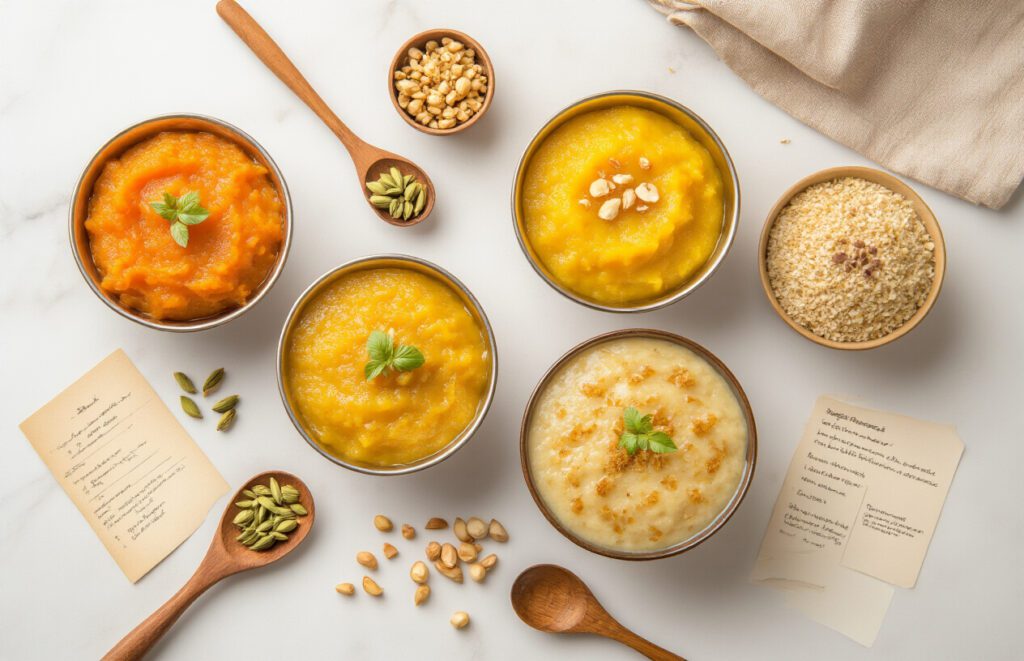
Timing strategies to prepare multiple halwas efficiently
Prepare ingredients the night before to streamline your halwa-making process. Grate carrots for gajar halwa recipe, soak and grind moong dal, and measure out all dry ingredients. Start with moong dal halwa since it requires the longest cooking time, then move to wheat halwa while the dal simmers. Suji halwa recipe works best last since it cooks fastest and stays warm longer.
Texture adjustments for different preferences
Control halwa consistency by adjusting liquid ratios and cooking times. For creamy carrot halwa recipe, add extra milk gradually during cooking. Thick halwa lovers should cook longer until moisture evaporates completely. Smooth semolina halwa needs constant stirring, while coarser textures require less intervention. Add ghee incrementally to achieve your preferred richness level.
Solutions for common cooking problems
Problem | Solution |
|---|---|
Lumpy suji halwa | Roast semolina properly before adding liquid |
Burnt bottom | Use heavy-bottomed pan, reduce heat |
Watery consistency | Cook uncovered longer to evaporate excess moisture |
Too sweet | Balance with cardamom or nuts |
Rescue overcooked halwa by adding warm milk gradually. If your traditional indian sweets turn out too dry, incorporate melted ghee while still hot. Prevent sticking by stirring continuously during the final cooking stages.
My Zone
As a child, I was a die-hard foodie, and when it came to food, the law of diminishing utility simply didn’t apply to me. Among all the treats, Gajar ka Halwa held a very special place in my heart. My mother’s Suji ka Halwa—known in the South as Rava Kesari—was another delight I could never resist.
With time, as I grew more conscious of health and fitness, my relationship with food evolved. I became selective about what I ate, and sweets, particularly halwas, slowly disappeared from my everyday menu. Yet, there was one indulgence I could never completely give up—Gajar ka Halwa. To strike a balance, I made a pact with myself: avoid sugar throughout the year, and then reward myself during the winter, when markets overflow with fresh, red carrots.
Come winter, I set myself free and indulge wholeheartedly. At home, we prepare Gajar ka Halwa, and I relish it guilt-free at least three to four times every season. Recently, I discovered a healthier twist—preparing it with apples and dates as natural sweeteners instead of refined sugar. The best part? The taste remains divine, allowing me to enjoy my favorite winter dessert without a shred of guilt.
Frequently Asked Questions (FAQs)
1. Which halwa is the easiest for a beginner to make?
The Suji Halwa (Semolina Halwa) is the quickest and easiest to master. It has fewer steps than the milk-based recipes and primarily requires careful roasting of the semolina and gradual addition of liquid to avoid lumps.
2. Why did my halwa turn out watery instead of thick?
This is usually due to insufficient cooking or adding sugar too early. To fix it, continue cooking the mixture on low heat, stirring constantly to evaporate the excess moisture. Always add sugar only after the main ingredient is fully cooked.
3. How can I make a healthier version of halwa?
You can substitute refined sugar with natural sweeteners like jaggery, dates, or mashed apples. You can also slightly reduce the amount of ghee, though it is essential for the authentic flavor. Using low-fat milk is another option for the milk-based halwas.
4. What is the most important tool for making halwa successfully?
A heavy-bottomed pan is crucial. It distributes heat evenly, which prevents the halwa from burning during the long, slow cooking and constant stirring required to achieve the perfect texture.
Final Thoughts
Mastering the art of halwa is more than just learning a recipe; it’s about embracing a cherished tradition that turns simple, humble ingredients into something truly divine. Whether it’s the slow-simmered richness of Gajar ka Halwa, the protein-packed warmth of Moong Dal Halwa, the quick comfort of Suji Halwa, or the wholesome goodness of Wheat Halwa, each variant offers a unique experience for your palate and your soul.
Remember, the key to a perfect halwa lies not in complexity, but in patience and attention to detail—the steady stirring, the gentle roasting, and the balance of flavors. Don’t be discouraged by minor setbacks; even experienced cooks learn to adjust consistency and flavor along the way.
Most importantly, let these recipes be a starting point for your own creativity. Cook them for love, for celebration, or for a simple moment of comfort. Share them with family, create new memories, and perhaps even pass down your own perfected version, adding your story to this delicious, generations-old legacy.




